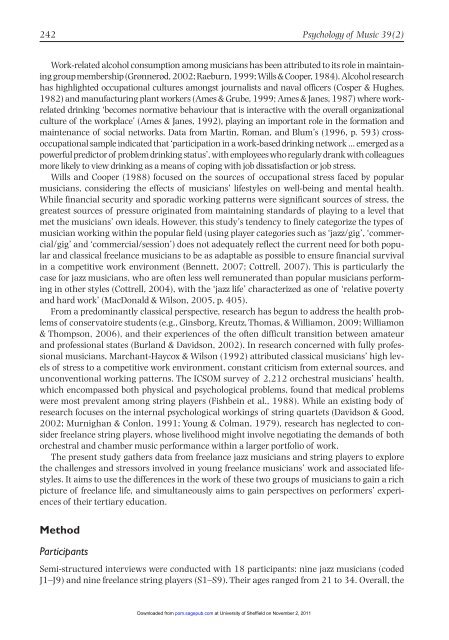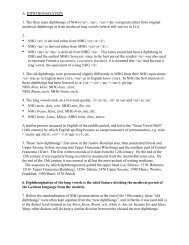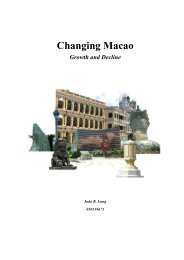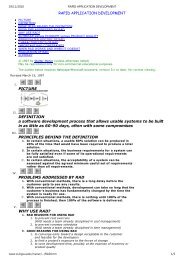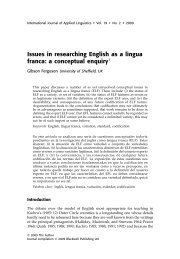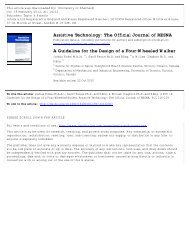Dobson, 2010.pdf - University of Sheffield
Dobson, 2010.pdf - University of Sheffield
Dobson, 2010.pdf - University of Sheffield
You also want an ePaper? Increase the reach of your titles
YUMPU automatically turns print PDFs into web optimized ePapers that Google loves.
242 Psychology <strong>of</strong> Music 39(2)<br />
Work-related alcohol consumption among musicians has been attributed to its role in maintaining<br />
group membership (Grønnerød, 2002; Raeburn, 1999; Wills & Cooper, 1984). Alcohol research<br />
has highlighted occupational cultures amongst journalists and naval <strong>of</strong>ficers (Cosper & Hughes,<br />
1982) and manufacturing plant workers (Ames & Grube, 1999; Ames & Janes, 1987) where workrelated<br />
drinking ‘becomes normative behaviour that is interactive with the overall organizational<br />
culture <strong>of</strong> the workplace’ (Ames & Janes, 1992), playing an important role in the formation and<br />
maintenance <strong>of</strong> social networks. Data from Martin, Roman, and Blum’s (1996, p. 593) crossoccupational<br />
sample indicated that ‘participation in a work-based drinking network ... emerged as a<br />
powerful predictor <strong>of</strong> problem drinking status’, with employees who regularly drank with colleagues<br />
more likely to view drinking as a means <strong>of</strong> coping with job dissatisfaction or job stress.<br />
Wills and Cooper (1988) focused on the sources <strong>of</strong> occupational stress faced by popular<br />
musicians, considering the effects <strong>of</strong> musicians’ lifestyles on well-being and mental health.<br />
While financial security and sporadic working patterns were significant sources <strong>of</strong> stress, the<br />
greatest sources <strong>of</strong> pressure originated from maintaining standards <strong>of</strong> playing to a level that<br />
met the musicians’ own ideals. However, this study’s tendency to finely categorize the types <strong>of</strong><br />
musician working within the popular field (using player categories such as ‘jazz/gig’, ‘commercial/gig’<br />
and ‘commercial/session’) does not adequately reflect the current need for both popular<br />
and classical freelance musicians to be as adaptable as possible to ensure financial survival<br />
in a competitive work environment (Bennett, 2007; Cottrell, 2007). This is particularly the<br />
case for jazz musicians, who are <strong>of</strong>ten less well remunerated than popular musicians performing<br />
in other styles (Cottrell, 2004), with the ‘jazz life’ characterized as one <strong>of</strong> ‘relative poverty<br />
and hard work’ (MacDonald & Wilson, 2005, p. 405).<br />
From a predominantly classical perspective, research has begun to address the health problems<br />
<strong>of</strong> conservatoire students (e.g., Ginsborg, Kreutz, Thomas, & Williamon, 2009; Williamon<br />
& Thompson, 2006), and their experiences <strong>of</strong> the <strong>of</strong>ten difficult transition between amateur<br />
and pr<strong>of</strong>essional states (Burland & Davidson, 2002). In research concerned with fully pr<strong>of</strong>essional<br />
musicians, Marchant-Haycox & Wilson (1992) attributed classical musicians’ high levels<br />
<strong>of</strong> stress to a competitive work environment, constant criticism from external sources, and<br />
unconventional working patterns. The ICSOM survey <strong>of</strong> 2,212 orchestral musicians’ health,<br />
which encompassed both physical and psychological problems, found that medical problems<br />
were most prevalent among string players (Fishbein et al., 1988). While an existing body <strong>of</strong><br />
research focuses on the internal psychological workings <strong>of</strong> string quartets (Davidson & Good,<br />
2002; Murnighan & Conlon, 1991; Young & Colman, 1979), research has neglected to consider<br />
freelance string players, whose livelihood might involve negotiating the demands <strong>of</strong> both<br />
orchestral and chamber music performance within a larger portfolio <strong>of</strong> work.<br />
The present study gathers data from freelance jazz musicians and string players to explore<br />
the challenges and stressors involved in young freelance musicians’ work and associated lifestyles.<br />
It aims to use the differences in the work <strong>of</strong> these two groups <strong>of</strong> musicians to gain a rich<br />
picture <strong>of</strong> freelance life, and simultaneously aims to gain perspectives on performers’ experiences<br />
<strong>of</strong> their tertiary education.<br />
Method<br />
Participants<br />
Semi-structured interviews were conducted with 18 participants: nine jazz musicians (coded<br />
J1–J9) and nine freelance string players (S1–S9). Their ages ranged from 21 to 34. Overall, the<br />
Downloaded from<br />
pom.sagepub.com at <strong>University</strong> <strong>of</strong> <strong>Sheffield</strong> on November 2, 2011


